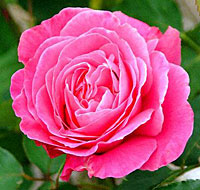Paul McCartney's not looking so good. In fact, he's suffering from powdery
mildew. At the same time, Barbra Streisand is bursting with good health
-- green and glossy. 
Of course, it's not Paul and Barbra themselves that provide such a contrast, but rather their two namesake roses in a San Francisco garden. That's because regardless of whether you prefer "Yesterday" to "The Way We Were," the McCartney rose is less resistant to fungal diseases than the Streisand rose.
A smart green gardener wouldn't plant a McCartney rose in San Francisco's fog belt, because black spot, rust, and powdery mildew are typically controlled by spraying fungicide. And roses that have been weakened by disease will also be more susceptible to attacks from other garden pests. That's why it's best to choose the right rose before you plant. Here's what you need to know:
Do your research. First do a little research to find out what kinds of roses do well in your climate. As a rule, all roses like lots of sunlight, but some varieties will tolerate partial shade as well as cooler, wetter environments better than others. Rugosa roses -- which include a wide number of varieties -- are particularly well-known for their disease resistance. Also, older varieties tend to be hardier (and better smelling) than newer ones. Miniature roses are also good.
Water smarter. Roses need lots of water, but it's important to do it right. Wet leaves can lead to blackspot fungus, so use a soaker to do a deep slow watering. This will also encourage deep roots and a healthy plant.
Air things out. Wet leaves don't contribute to powdery mildew (although a damp climate does). Keep plants that might be susceptible to this fungus healthy by pruning them so that they get plenty of air circulation. Plenty of sunlight and airflow is the goal.
Show some restraint. If black spot or powdery mildew appears on your plants in spite of all your precautions, don't immediately reach for the fungicide. For one thing, the fungicide won't "cure" fungus -- it's only effective as a preventative and to prevent spreading. First, remove all diseased leaves from the plant to stop the spread of disease. Then try spraying with a baking soda mixture to change the pH of the leaves. Combine 1 1/2 tablespoon baking soda and either 2 tablespoons horticultural oil or a few drops of Ivory liquid with 1 gallon of water. Mix well and spray both sides of the leaves once a week.
![]()
Please direct any inquires or comments to susan@not2tech.com
The creator of this page claims no rights or ownership to any of the images
or text therein.